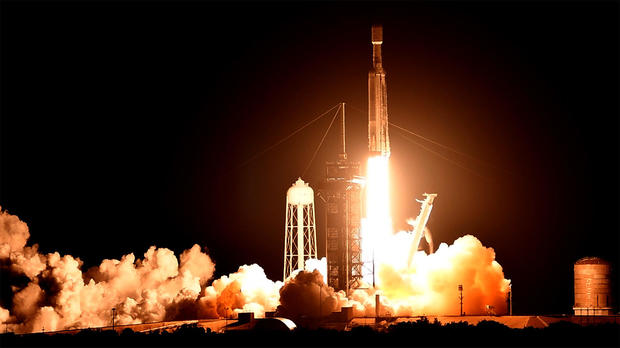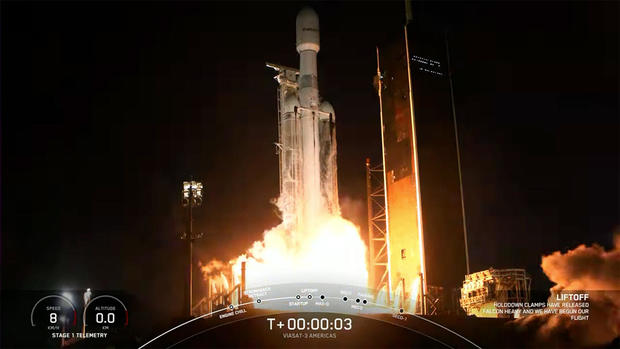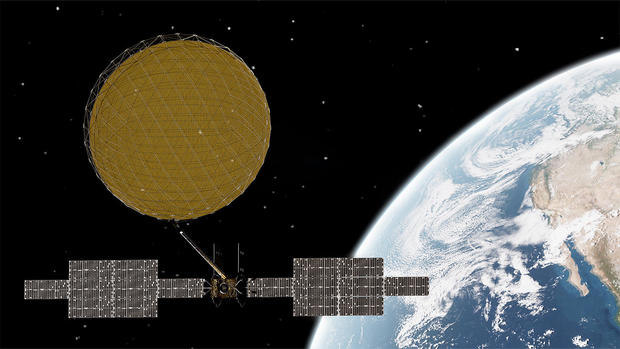SpaceX Falcon Heavy launches powerful ViaSat internet relay satellite
After multiple delays for weather and technical issues, SpaceX finally launched a Falcon Heavy rocket Sunday carrying a competitor's internet satellite, the first of three next-generation data relay stations capable of terabyte-per-second performance.
After a final hour-long delay because of gusty winds, SpaceX's most powerful operational rocket flashed to life at 8:26 p.m. EDT and climbed away from historic pad 39A at the Kennedy Space Center atop more than 5 million pounds of thrust.

Powered by 27 Merlin engines in three strapped-together Falcon 9 first stage boosters, the Falcon Heavy quickly accelerated as it consumed its kerosene and liquid oxygen propellants and lost weight. After initially climbing straight up, the rocket arced over on an easterly trajectory, putting on a spectacular early-evening show for area residents and tourists.
SpaceX normally recovers first stage boosters for refurbishment and reuse, but all of the available propellant was needed Sunday to boost the 13,000-pound ViaSat-3 satellite into its planned orbit.
As a result, all three core stages were discarded to fall into the ocean more than 50 miles below after pushing the rocket out of the lower atmosphere.
The single engine powering the Falcon Heavy's upper stage shut down eight minutes after launch, putting the vehicle in an initial parking orbit. Two more firings were planned over the next three hours and 44 minutes to get the satellite into the planned geosynchronous orbit 22,300 miles above the equator.

Sunday's flight capped an intense few days for SpaceX, which launched 46 of its own low-altitude Starlink internet satellites from Vandenberg Space Force Base in California on Thursday. The company then launched two medium-altitude broadband satellites for Luxembourg-based SES from the Cape Canaveral Space Force Station on Friday.
All three launchings highlight the ongoing race to deploy space-based internet relay stations to provide broadband access to customers anywhere in the world, including rural, hard-to-reach or under-served areas, as well as aircraft and ships at sea.
The Starlink satellites are part of a fast-growing constellation of small, low-altitude laser-linked satellites designed, built and operated by SpaceX to provide high-speed, low-latency internet to users anywhere in the world.
Thousands of Starlinks are required to ensure that multiple fast-moving satellites are above a user's horizon at any given moment to provide uninterrupted service. The satellites receive user inputs, and send those to nearby Starlinks for relay to "gateway" ground stations connected to high-speed data lines. Responses are then passed along back to the user.

ViaSat is taking a different approach, stationing satellites in 22,300 mile-high-orbits above the equator where they rotate in lockstep with the planet below and thus appear stationary in the sky. Three such ViaSat-3 satellites are planned to provide global space-based internet access on hemispheric scales.
The powerful satellites are equipped with huge solar panels generating 25 kilowatts of power and stretching 144 feet from tip to tip when fully unfolded.
Capable of handling up to 1 terabyte of data per second, the satellites are equipped with the largest dish antenna ever launched on a commercial satellite. Once on station, the huge mesh reflector will unfold atop an 80- to 90-foot-long telescoping boom based on technology developed for the James Webb Space Telescope.
If all goes well, the first ViaSat-3 will provide internet access to customers in the Western Hemisphere starting this summer. Two more satellites, covering Europe, Africa, Asia and the Pacific, are expected to launch over the next two years.
"If you are a low-Earth orbit (provider), by definition, in order to stay up in orbit, you're going to be screaming across the sky fairly fast. So your terminal on the ground has to be more complicated ... and more expensive," David Ryan, president of space and commercial networks at ViaSat, told CBS News.
"The other advantage of geosynchronous orbit is that you can see a third of the Earth with one satellite. So with one launch, one satellite, you potentially can connect to a third of the Earth. And that's the principle behind ViaSat-3."
- In:
- Elon Musk
- Jeff Bezos
- Virgin Galactic
- Blue Origin
- Richard Branson

Bill Harwood has been covering the U.S. space program full-time since 1984, first as Cape Canaveral bureau chief for United Press International and now as a consultant for CBS News. He covered 129 space shuttle missions, every interplanetary flight since Voyager 2's flyby of Neptune and scores of commercial and military launches. Based at the Kennedy Space Center in Florida, Harwood is a devoted amateur astronomer and co-author of "Comm Check: The Final Flight of Shuttle Columbia."
TwitterDisclaimer: The copyright of this article belongs to the original author. Reposting this article is solely for the purpose of information dissemination and does not constitute any investment advice. If there is any infringement, please contact us immediately. We will make corrections or deletions as necessary. Thank you.







